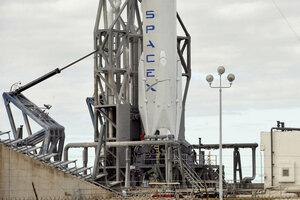SpaceX attempts historic rocket launch Monday. Here's how to watch it.
SpaceX postponed its Sunday launch until Monday. The mission to get 11 satellites into space is a relatively simple one, a good thing for a launch with such bold ambitions.

A remodeled version of the SpaceX Falcon 9 rocket rests on its pad as it is prepared for launch at the Cape Canaveral Air Force Station on the launcher's first mission since a June failure in Cape Canaveral, Florida December 20, 2015. The rocket carries a payload of eleven satellites owned by Orbcomm, a New Jersey-based communications company.
Steve Nesius/Reuters
MONDAY MORNING UPDATE: SpaceX postponed its Sunday launch until Monday evening, at 8:33 p.m.
SpaceX is making a return to the launch pad with a mission to put its Falcon 9 orbital rocket into space, and then return its booster safely back to Earth, a spaceflight first.
Launching for the first time since being sidelined in June, when a Falcon 9 disintegrated shortly after liftoff, an upgraded version of the rocket is anticipating liftoff at 8:29 p.m. on Sunday from Cape Canaveral Air Force Station.
SpaceX on Saturday afternoon said the timing may still subject to change, but CEO Elon Musk said on Twitter that conditions were good for an “orbital launch and rocket landing at Cape Canaveral.”
To watch, tune into the webcast here.
The Orbcomm mission is a relatively simple one, a good thing for a launch with such bold ambitions.
With upgrades that have increased its thrust at liftoff to 1.5 million pounds, the Falcon 9 will far exceed the power it needs to get Orbcomm's 11 communications satellites to a low orbit.
The increase to the Falcon 9's thrust is an important long-term improvement for SpaceX, allowing it to launch heavier payloads. A key challenge – if the commercial satellite industry is to be competitive – is for launches to be relatively cheap. Musk argues that the only way to cut costs on rocket launches is to bring back and reuse spent rocket stages.
“It’s really a massive difference if we can make reusability work,” Musk said last week.
About a month ago, Blue Origin – the space company backed by Amazon founder and CEO Jeff Bezos – was the first to successfully launch a rocket into space and then land it safely back on Earth. The rocket, called New Shepard, ferried an unmanned crew capsule a little more than 100 kilometers from Earth, to the edge of space. New Shepard then released the capsule, and returned to Earth – coming down at just 4.4 mph through the last 100 feet, according to Mr. Bezos, before touching down on its landing pad.
Shepard's return was a first, but Musk appears poised to one-up his competitor Sunday evening.
Blue Origin's rocket achieved a suborbital roundtrip, meaning Shepard never quite achieved the speed or height necessary to go into orbit. SpaceX's Falcon 9, however, is the company's most powerful rocket, and is expected to make it to orbit, making it the first orbital rocket to execute a return.
As Phil Plait, an astronomer-columnist for Slate, wrote of the advantages of this particular Falcon 9:
It will be the company’s first try at relanding the booster on dry land; all previous attempts have been at sea. None has been successful, in the sense of the booster landing and remaining upright, but each was a remarkable engineering feat in getting it to the floating landing platform at all.
I would assume that the lessons learned from those tests are why SpaceX is confident enough to try a literal landing this time. In some ways it’s easier; the floating platforms can bob up and down in the water while land tends to be steady. But having something at sea means it’s farther along the launch path, so less fuel is needed to bring the booster back. However, this launch will be of the new “Full Thrust” version of the F9, which has added capabilities (more fuel capacity and reduced overall mass), so that should make it easier to get the booster back to the launch site.
If the launch is successful, those nearby can expect a rumble from the rocket’s climb toward space, and a sonic boom that means the Falcon 9's booster is making its return into the atmosphere.
According to Florida Today, observers can then possibly expect to see "the orange glow of an engine firing in darkness to slow the booster’s descent toward concrete pads at SpaceX’s 'Landing Complex 1' near the nose of Cape Canaveral."
If the booster lands, the celebration may be short. SpaceX still has work to do.
The private space company has a list of satellite customers awaiting rides, and NASA has the Falcon 9 and Dragon reserved to fly cargo to and from the International Space Station. In the next two years, the space agency expects SpaceX to start bringing astronauts onboard its rockets.

